How to Survive A Bear Attack: Tips to Ensure You Come Back Home
Whether you consider yourself experienced in wilderness survival or are just an enthusiast, you have to make sure that the right information gets to you. Among the things you need to absolutely know is the type of wildlife you will encounter when you’re out and how you should interact with these creatures.
[the_ad_group id=”21″]
One of the worst possible close-encounters for many nature enthusiasts is to be up close and personal with a bear. With this in mind, we’re going to talk about how to survive a bear attack and the things you should do to improve your chances.
No Encounter Is The Best Encounter
This cannot be stressed enough. Bears are naturally built bigger, faster, and stronger than people. Bearing these things in mind, one should take extra precautions when out in the wild, especially when in bear territory.

And while it isn’t really possible to completely reduce the risk of a bear encounter to zero, there are a lot of ways to improve your chances.
- Stay out of bear country: This is a piece of advice as straightforward as it gets. Data on bear populations isn’t scarce. Numerous bodies monitor the populations of various bear species and where they are concentrated. Staying away from potential hazards is your best bet for avoiding a bear encounter.
- Travel in groups: The old adage that goes there is strength in numbers is very true. A larger number of scents and voices can provide a better deterrent for bears over an individual person wandering alone. In fact the latter may even pique the curiosity of a younger bear. In the event that a bear does attack, having several people distracting its attention will definitely improve your chances. Also, there is no recorded instance of a bear attacking a group of six or more people.
- Make some noise: If and when hiking (in larger groups if you followed the previous piece of advice) avoid being the quiet hiker. Making noise, and letting out some chatter can help dissuade any bears from approaching you.
- Minimize scents: Bears have highly developed olfactory senses. Their noses are more effective at tracking food than dogs. They love human food. So be wary of what you put out on the campsite. Perfume, deodorant, and mints can all contribute to making a bear curious. Check out our top list of odor-proof bags for backpacking to keep safe from these wild animals.
- Be aware of your surroundings: This is using common sense. If you spot fresh bear tracks, scat, large berry patches, or banks on streams where bears may feed or drink water. Stay on your toes. If possible do not linger, move on.
- Give them a wide berth: If you spot one at a distance, back off. Do not try to get close, or take a photo. Many of recent bear attacks were caused by people trying to get close enough for a picture of a bear. The sooner you leave its immediate vicinity, the safer you will be. Despite their size and seemingly slow movements, they can cover long distances in a very short span of time. This is especially the case if you spot a bear over a carcass or with cubs. You don’t want to be anywhere near it at this point, and it doesn’t want anything to do with you. Back off immediately.
Equip Yourself for an Encounter
If you’re out trekking, chances are you’ve bothered to put together a reasonable amount of gear. Aside from the usual survival essentials, it would be wise to pack for a possible encounter with a bear.
Bear Spray
This is generally agreed to be the most potent form of defense against a bear. These sprays are pretty much pepper spray, but are much stronger. The efficacy of these sprays in the event of a bear attack shouldn’t be understated.
In fact a study by a US Interagency group noted that people who were equipped with bear spray were much likely to escape a bear encounter unscathed with only 2% of respondents getting injured. Gun users on the other hand had a 50% rate of injury.
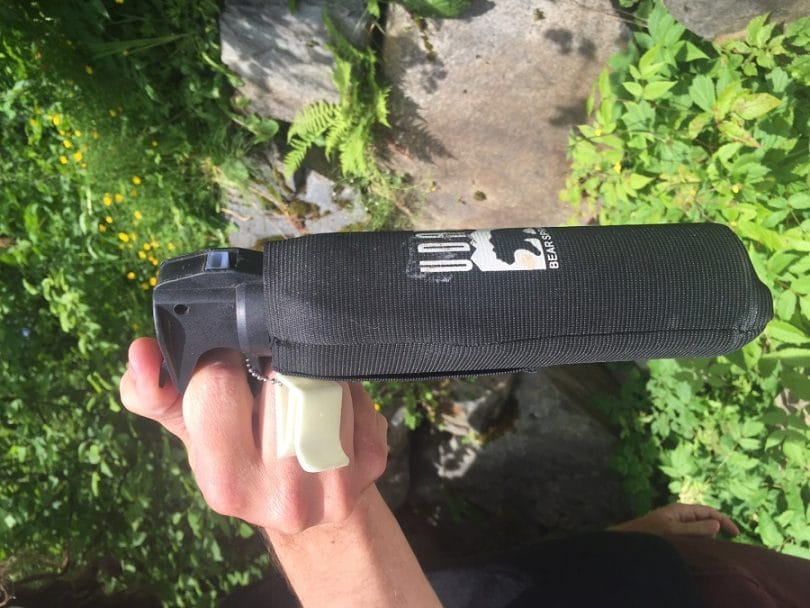
These sprays usually have a range of 7-10 feet, and can mean the difference during a close encounter. The spray creates a very strong stinging sensation especially for bears and their heightened olfactory senses.
If you bother to bring spray it’s important to have it ready to bear at a moment’s notice. Keeping it lodged deep within your pack is definitely a bad idea. Your best option is to holster it at your side. Also reading instructions before going out is a must. You will not have the time to read that piece of paper as a bear comes charging at you. To find out how to choose the best bear pepper sprays to guide you, check our earlier article on this topic.
Some parks will rent these sprays out. Alternatively, should you wish to make a purchase, they cost in the range of $50 a canister. These sprays are legal throughout the United States but they are illegal when acquired through a non-licensed pharmacist or if purchased with intent to use on a person (in Canada anyway).
Firearms
As mentioned earlier, this may not be such a good idea as a bear coming at you will do so at full-speed. That’s 400-700lbs of muscle, meat, claws, and teeth barreling at you at speeds up to 40mph. It’s not a very exciting prospect. Check out our piece on the best pump shotgun to help you protect yourself from these predators.
Taking into consideration the massive size and thick skeleton bears tend to have, light firearms will generally not do the job of stopping it. And that’s something you can have the luxury of thinking about only in the case when you manage to land a bullet on the bear.
Considering the general shock state, the first shot from your firearm will probably miss. And given the speed of a bear and considering that weapons have recoil, you’re going to have a short amount of time to line up a second shot, which, even if it does connect has no guarantee of downing the beast.

In the event that you do want to arm yourself with a gun (assuming that it’s legal in the state that you’re in, and you have papers for the weapon) you will want to have a high-caliber weapon. Many recommend the 12 gauge shotgun, as ease of aiming and caliber of munitions can sway the tide.
[the_ad_group id=”22″]
Using a weapon will potentially aggravate a situation with a bear, hence it is really not recommended – unless it’s a last resort. If ever you are afraid of legal penalties that may come with slaying the bear, your primary concern should be your life and safety, as well as the people around you. So long as the weapon is registered and has proper documentation, using it as a means to self-defense should not be an issue.
Axe/Knife/Blade
Many wilderness enthusiasts will be packing these in their gear, should they ever go trekking. The reality however, is that bears can usually down elk and deer with a swipe of their paw. The assumption works for humans as well. If you get hit, you will go down. To find out how to choose the best combat knives that can help protect yourself, see our earlier piece on this topic.
However in a worst case scenario, wherein you absolutely have to fight (this will largely depend on the species of bear you’re up against) a weapon will be more effective than a bared fist.

Keep in mind: Playing dead isn’t recommended on some bear species.
Mental Preparation
The most important tool in your arsenal during any emergency situation is a controlled state-of-mind. We aren’t going to say calm, because being face to face with a 7-foot tall brown bear isn’t something you can probably ever be calm about. However, allowing your mind to descend into panic mode isn’t going to help.

It’ll muddle your judgment and potentially put you and the people you’re with in danger. To improve your chances, it’s best to prepare yourself with the right knowledge on dealing with these predators should it ever come down to an actual confrontation. These are a few things you will need to take mental note of.
- Never run – Don’t run! Unless you can top Usain Bolt’s speed on uneven terrain it’s a bad idea. Bears, as with many big predators have the instinct to chase down runners. It’s either the prey gets away or they get winded, and sadly humans aren’t built fast enough to outrun these guys.
- Don’t Make Eye Contact – This isn’t a movie. Making eye contact with a wild animal may be perceived as a threat or a challenge. Presenting yourself as either is a bad idea. If a bear gets up and stands on its hind legs, don’t worry. It’s trying to get a better view and scent to better assess the situation.
- No sudden movements – Making quick and sudden movements may be perceived as threatening by a bear. You don’t want that. It’s best for you to move slowly and try to make yourself look as big as possible. Speak firmly, and slowly and back away.
- Keep track of your surroundings – keep an eye on your surroundings. You don’t want to allow yourself to be backed into a corner if the attack is aggressive. If you stumble upon a bear, also be sure that it isn’t backed in. The most dangerous animals are those that have nowhere to run. Slowly move yourself to an advantageous position and allow a bear enough space to leave. Higher ground is also ideal as it will have a tougher time charging at you.
Know Your Bears
It’s important to familiarize yourself with what species of bear live in the territory where you intend to camp. The behavior of bears varies depending on species and the way you react to one that is potentially hostile can make or break an impending attack. If various bear species live in a particular area, you will want to figure out which is which.
Brown Bear
Grizzly bears and Kodiak bears fall under this general category. One of the tell-tale characteristics of a brown bear is an evident shoulder protrusion or hump. Overall these are bigger than their black bear cousins. They have bigger claws, stature and head sizes than black bears.
The average height of a brown bear is 6.5ft and up to 9ft. They can come in brown, blond or black coats. So the name “brown bear” can be a bit of a misnomer. They also have a concave facial profile.

It’s important to assess the bear if ever it behaves aggressively. If you are absolutely sure about it belonging to the brown bear category, your best bet is to play dead if it charges you or gets too close. Brown bear attacks are generally defensive in nature and the bear gets upset possibly because it views you as a threat.
Playing dead makes it think that you are a neutralized threat and this is especially the case if you happen to encounter a brown bear with a cub. Lie down on your belly and spread out your legs and clasp your hands around the back of your neck.
Make it hard for the bear to turn you. Brown bears will generally back off once it becomes obvious that you aren’t a threat. When it does back away, continue to lay still. Bears will tend to wait around to see if you re-emerge as a potential threat. So don’t move.
However, if a brown bear does not cease to harass and begins to bite or eat you, you’re going to have to fight. Concentrate your blows on the facial area, snout and eyes are good targets. If you have any weapon on you, now is a good time to use it.
Black bear
These bears, while generally smaller than their brown counterparts are no less dangerous. On average they are at a 5ft height and weigh 250 lbs. Their smaller stature does not diminish the strength and speed advantage they have on humans.
You’ll be able to make one out due to the absence of the large shoulder humps and its facial profile. The face is straight relative to the concave profile of the brown bears.
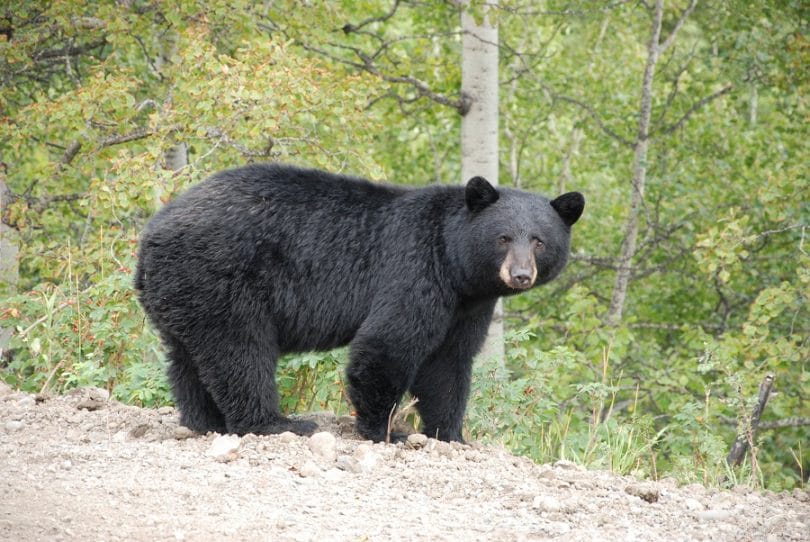
If you can identify a bear as a black bear then you’d better not play dead. The majority of black bear attacks are offensive in nature. This means that they’re looking for food. You may be blocking the way to it, or you may be perceived as a potential food source. Unlike the majority of brown bear attacks, these guys will back off if they perceive that you aren’t worth the effort.
If you lay down, then the black bear may perceive you as an easy meal. So stay upright and stand your ground. Make lots of noise to try and scare it off. These bears have a strong tendency to bluff charge at you, trying to make you turn your back and run. Don’t fall for it.
Types of Attacks
Attacks will be in two varieties: offensive/predatory, and defensive. How you approach a situation will be different depending on how the animal attacks (we’ve pretty much covered the basics of it in the section above).
Offensive/Predatory Attacks
These are done by bears to secure food. Guided by predatory instinct, these attacks are meant to kill. However, the motivation behind these attacks can be dissuaded. It’s important to note that presenting oneself as an unviable target for attack is the ideal.
If you have bear spray, use it as the bear approaches – shoot a small amount as it gets within a 25-30 ft. range to deter it. Bear spray usually does the trick as it is highly unpleasant for the bear.
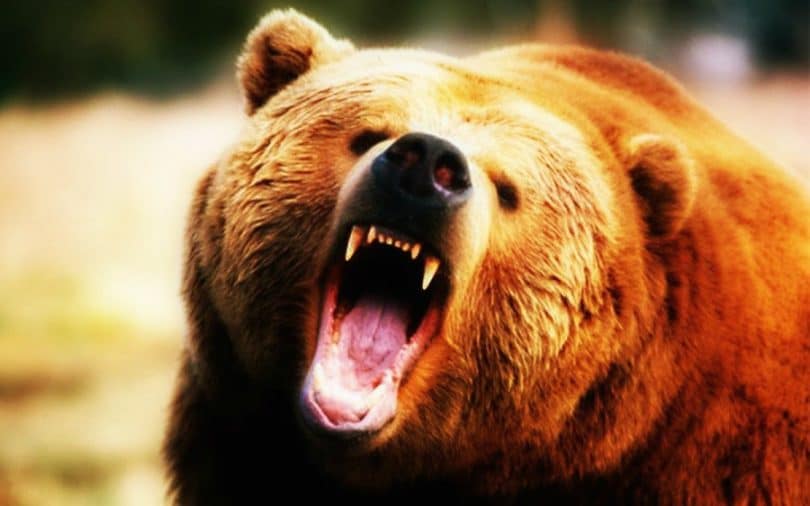
You can tell an attack is predatory if the bear doesn’t respond to aggressive actions such as throwing rock and sticks or yelling. If the bear grabs you and pulls you out of a tent, or if it enters into your building, tent, or house, it can be classified as a predatory attack. This bear is looking for food.
Defensive Attacks
These attacks are usually done in response to you being perceived as a threat. This is the common reason for brown bear attacks however the behavior isn’t limited to brown bears alone.
[the_ad_group id=”23″]
This type of attack usually happens because of a sudden and inadvertent encounter with a bear with cubs or a bear’s food cache. If this happens to be the case, the bear sees you as a threat and you should persuade it that you aren’t.
As was said earlier, lay on your belly with your hands protecting the back of your neck and legs apart. If you have a backpack on you, all the better – it’ll help provide some protection against the bear’s attack.
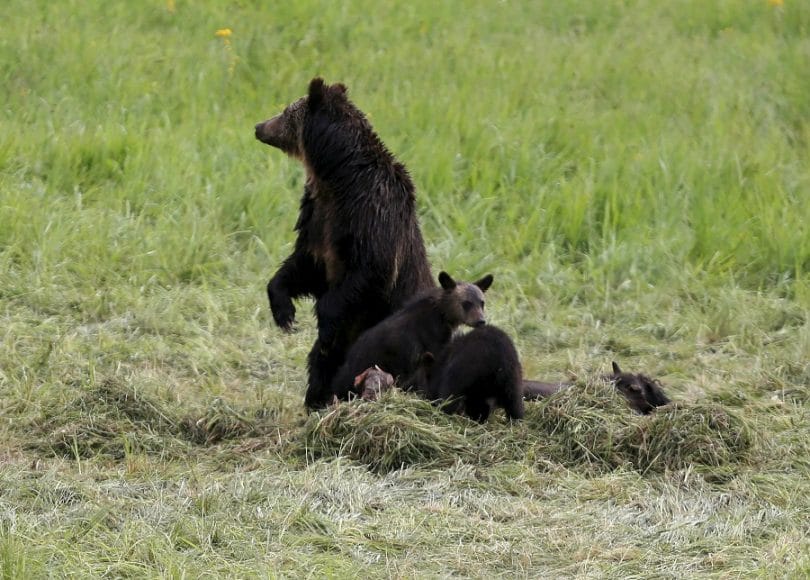
A bear that’s growling at you from a distance may not be all too excited about the prospect of attacking you. If it’s a mother with cubs, it will likely send those cubs up a tree and protect the base. This will give you ample time to back off.
In the end, remember that there’s always a possibility of something going wrong during an outdoor trip. So make sure that when you decide to go out, you’ve got the best possible protection for a bear attack. Equip yourselves and stay in groups.
If it still does happen, stay sharp, keep a level head, and be observant. Any error at this point can be costly, but with the right mindset and equipment surviving a bear attack is very much possible.


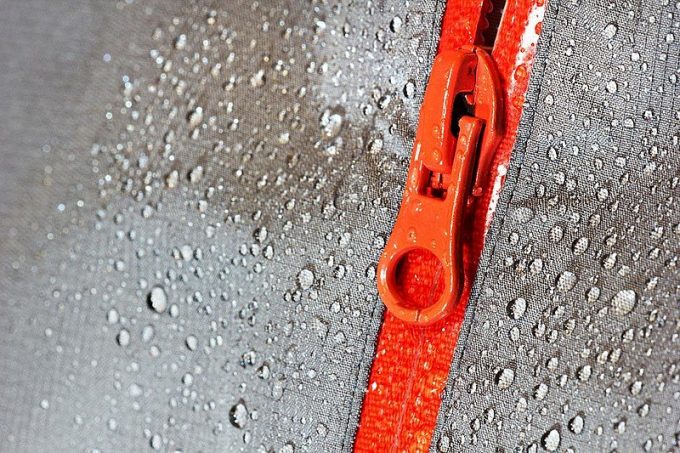




If you don’t have a bear spray, which is mentioned in this article, you can take a pepper spray. Experts often recommend that travelers always carry their pepper spray in the habitats of bears. Pepper sprays represent a highly concentrated substance — capsaicin, which creates a large cloud. This substance usually stops a bear and gives you the opportunity to escape. In any case, don’t run! If the bear sees a man running, he will take him for prey and begin to pursue. Don’t think you will be able to run away from him! The bear can reach speeds of 30+ m/h., so if you’re not an Olympic Sprinter, you’d better not run.
Focus is indeed one of the main keys on how to survive a bear attack. I agree, running should never be an option because you’ll just end up being mauled. In addition to this, make sure you use the pepper spray correctly and within the target range.
If you don’t have a bear spray, which is mentioned in this article, you can take a pepper spray. Experts often recommend that travelers always carry their pepper spray in the habitats of bears. Pepper sprays represent a highly concentrated substance — capsaicin, which creates a large cloud. This substance usually stops a bear and gives you the opportunity to escape. In any case, don’t run! If the bear sees a man running, he will take him for prey and begin to pursue. Don’t think you will be able to run away from him! The bear can reach speeds of 30+ m/h., so if you’re not an Olympic Sprinter, you’d better not run.
Focus is indeed one of the main keys on how to survive a bear attack. I agree, running should never be an option because you’ll just end up being mauled. In addition to this, make sure you use the pepper spray correctly and within the target range.
Just like people, bears use trails and roads. Don’t set the tent near the trail by which they may pass. Avoid places where you smell a dead fish, animal, or see an animal feeding with carrion. There may be the food for a bear, and if he is around, he can defend his stash. Usually, in such places, the bear makes a rookery.
They do have keen sense of smell so if you’re around the areas with carrion or strong scents, you really have to move out. You don’t want to be the next viable target. Preventing them from seeing you is the key to survival as well.
Just like people, bears use trails and roads. Don’t set the tent near the trail by which they may pass. Avoid places where you smell a dead fish, animal, or see an animal feeding with carrion. There may be the food for a bear, and if he is around, he can defend his stash. Usually, in such places, the bear makes a rookery.
They do have keen sense of smell so if you’re around the areas with carrion or strong scents, you really have to move out. You don’t want to be the next viable target. Preventing them from seeing you is the key to survival as well.